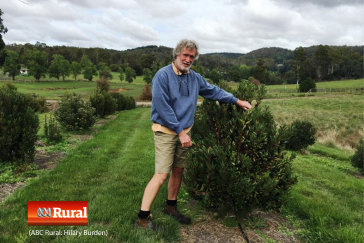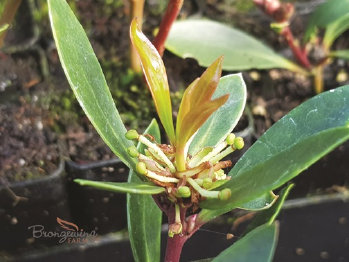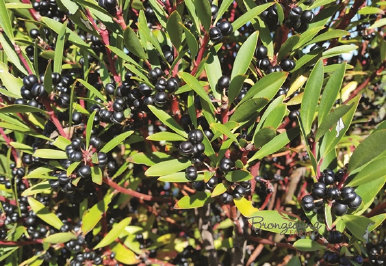
Male flowers:


© Bronzewing Farm 2013-24
Mountain Pepper Production:
Berry Harvesting: Bronzewing Farm(R) Tasmanian DEVIL(R) Mountain Pepperberries are
hand-harvested from the farm between April and June every year.
Hand-harvesting is necessary because (a) the berries don't seem
to want to drop off naturally (in our greenhouses we can have last season's berries still on the plant when the current season's berries
are developing), and (b) it is important not to damage the new buds/growth which develop in the centre of the whorl of berries.
This growth habit is called monopodial branching (see the lower-right photograph). Hand-harvesting is why Tasmanian Mountain
Pepper is so expensive - there are around 4,000 berries in 1 kg of Mountain Pepper Berries (and this only gives you around 250 g of
dried Mountain Pepper...). See our harvesting video here.
The fresh pepperberries are graded to remove twigs and leaves
but we typically leave the berry stems on those fruits where they haven't fallen off during harvest. We do this, because they
add an 'authentic' look to our "Devil" peppercorns. Also the stems are just as 'hot' as the berries.

New shoots emerge from the centre of the whorl of berries - meaning you have to be careful not to damage buds during harvest.

Pepperberries ready for harvest
Harvesting

Alternate bearing/Biennial bearing: Mountain Pepper appears to produce big crops one year and small crops the next. For suppliers
harvesting directly from the native bush, this is a big problem as their supplies are very limited on a regular basis. This
biennial bearing is very typical of fruit crops such as apples, peaches, etc, and growers try to reduce this habit by thinning heavy
crops either at flowering or at early fruit set.
Our farmed production of Tasmanian DEVIL(R) pepper means we can predict and
plan for this. We also view the process differently - we have a baseline production..., and some years, we have a surplus of
berries.
In the future we will look at how prunning, fertilization and other crop management practices can reduce the extent
of alternate bearing. The figure below shows the biennial nature of our ACR1 cultivar which was planted in 2010 and produced
an initial crop in 2016.


